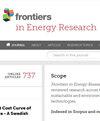利用电鳗觅食优化器提取光伏电池模型参数
IF 2.6
4区 工程技术
Q3 ENERGY & FUELS
引用次数: 0
摘要
在环境问题和气候变化的推动下,太阳能已成为全球向可再生能源过渡的关键解决方案。这主要归功于太阳能的清洁性、可用性和成本效益。精确评估光伏(PV)模型中的隐藏因素对于有效利用这些系统的潜力至关重要。本研究采用了一种新颖的参数估计方法,利用最近文献记载的电鳗觅食优化器(EEFO)来解决此类工程问题。EEFO 是一种具有竞争力的元启发式方法,在实现精确参数提取方面发挥着至关重要的作用。为了保持科学的完整性和公平性,本研究采用法国 RTC 太阳能电池作为基准案例。我们将 EEFO 方法与牛顿-拉夫逊方法结合起来,使用一个共同的实验框架,对三种光伏模型(单二极管、双二极管和三二极管模型)进行参数调整。我们选择 RTC France 太阳能电池作为单二极管、双二极管和三二极管模型,因为它在该领域发挥着重要作用。它是 EEFO 方法的可靠评估平台。我们利用统计、收敛和耗时研究进行了全面评估,结果表明 EEFO 始终能达到较低的 RMSE 值。这表明 EEFO 能够准确估计电流电压特性。系统平稳的收敛行为进一步增强了其功效。将 EEFO 与其他竞争方法进行比较,可增强其在优化太阳能光伏模型参数方面的竞争优势,从而展示其在大幅提高太阳能利用率方面的潜力。本文章由计算机程序翻译,如有差异,请以英文原文为准。
Parameter extraction of photovoltaic cell models using electric eel foraging optimizer
Solar energy has emerged as a key solution in the global transition to renewable energy sources, driven by environmental concerns and climate change. This is largely due to its cleanliness, availability, and cost-effectiveness. The precise assessment of hidden factors within photovoltaic (PV) models is critical for effectively exploiting the potential of these systems. This study employs a novel approach to parameter estimation, utilizing the electric eel foraging optimizer (EEFO), recently documented in the literature, to address such engineering issues. The EEFO emerges as a competitive metaheuristic methodology that plays a crucial role in enabling precise parameter extraction. In order to maintain scientific integrity and fairness, the study utilizes the RTC France solar cell as a benchmark case. We incorporate the EEFO approach, together with Newton-Raphson method, into the parameter tuning process for three PV models: single-diode, double-diode, and three-diode models, using a common experimental framework. We selected the RTC France solar cell for the single-diode, double-diode, and three-diode models because of its significant role in the field. It serves as a reliable evaluation platform for the EEFO approach. We conduct a thorough evaluation using statistical, convergence, and elapsed time studies, demonstrating that EEFO consistently achieves low RMSE values. This indicates that EEFO is capable of accurately estimating the current-voltage characteristics. The system’s smooth convergence behavior further reinforces its efficacy. Comparing the EEFO with competing methodologies reinforces its competitive advantage in optimizing solar PV model parameters, showcasing its potential to greatly enhance the usage of solar energy.
求助全文
通过发布文献求助,成功后即可免费获取论文全文。
去求助
来源期刊

Frontiers in Energy Research
Economics, Econometrics and Finance-Economics and Econometrics
CiteScore
3.90
自引率
11.80%
发文量
1727
审稿时长
12 weeks
期刊介绍:
Frontiers in Energy Research makes use of the unique Frontiers platform for open-access publishing and research networking for scientists, which provides an equal opportunity to seek, share and create knowledge. The mission of Frontiers is to place publishing back in the hands of working scientists and to promote an interactive, fair, and efficient review process. Articles are peer-reviewed according to the Frontiers review guidelines, which evaluate manuscripts on objective editorial criteria
 求助内容:
求助内容: 应助结果提醒方式:
应助结果提醒方式:


